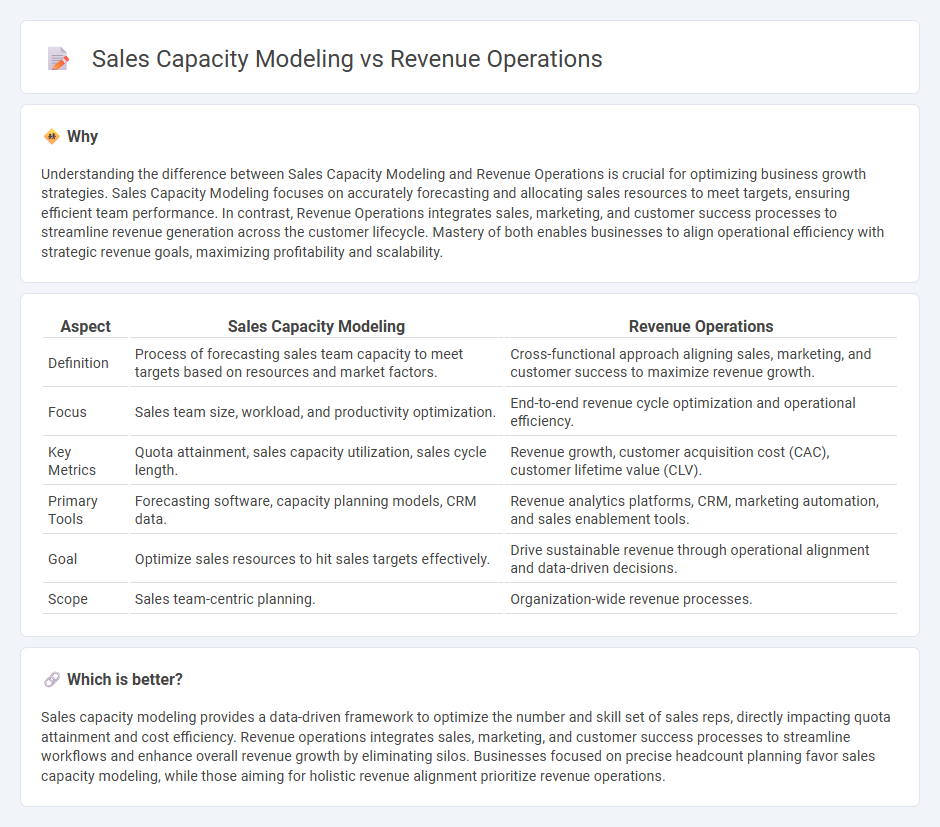
Sales capacity modeling provides precise projections of workforce needs based on historical data and market trends, optimizing team size and resource allocation. Revenue operations integrates sales, marketing, and customer success functions to streamline processes and maximize overall revenue growth. Explore how combining sales capacity modeling with revenue operations can elevate your business performance.
Why it is important
Understanding the difference between Sales Capacity Modeling and Revenue Operations is crucial for optimizing business growth strategies. Sales Capacity Modeling focuses on accurately forecasting and allocating sales resources to meet targets, ensuring efficient team performance. In contrast, Revenue Operations integrates sales, marketing, and customer success processes to streamline revenue generation across the customer lifecycle. Mastery of both enables businesses to align operational efficiency with strategic revenue goals, maximizing profitability and scalability.
Comparison Table
| Aspect | Sales Capacity Modeling | Revenue Operations |
|---|---|---|
| Definition | Process of forecasting sales team capacity to meet targets based on resources and market factors. | Cross-functional approach aligning sales, marketing, and customer success to maximize revenue growth. |
| Focus | Sales team size, workload, and productivity optimization. | End-to-end revenue cycle optimization and operational efficiency. |
| Key Metrics | Quota attainment, sales capacity utilization, sales cycle length. | Revenue growth, customer acquisition cost (CAC), customer lifetime value (CLV). |
| Primary Tools | Forecasting software, capacity planning models, CRM data. | Revenue analytics platforms, CRM, marketing automation, and sales enablement tools. |
| Goal | Optimize sales resources to hit sales targets effectively. | Drive sustainable revenue through operational alignment and data-driven decisions. |
| Scope | Sales team-centric planning. | Organization-wide revenue processes. |
Which is better?
Sales capacity modeling provides a data-driven framework to optimize the number and skill set of sales reps, directly impacting quota attainment and cost efficiency. Revenue operations integrates sales, marketing, and customer success processes to streamline workflows and enhance overall revenue growth by eliminating silos. Businesses focused on precise headcount planning favor sales capacity modeling, while those aiming for holistic revenue alignment prioritize revenue operations.
Connection
Sales capacity modeling directly influences Revenue Operations by providing accurate data on team performance and resource allocation, enabling optimized forecasting and quota setting. Revenue Operations relies on these insights to streamline sales processes, improve pipeline management, and maximize revenue growth. Integrating sales capacity models ensures alignment between sales efforts and organizational financial goals, driving operational efficiency.
Key Terms
Revenue operations:
Revenue operations integrate sales, marketing, and customer success functions to streamline processes, improve data accuracy, and enhance overall business efficiency. This approach leverages advanced analytics and automation tools to align cross-functional goals and drive predictable revenue growth. Explore how Revenue Operations can transform your revenue strategy with optimized workflows and data-driven insights.
Pipeline management
Revenue operations integrates data from sales, marketing, and customer success to streamline pipeline management and maximize revenue growth, using predictive analytics to identify high-value opportunities and reduce bottlenecks. Sales capacity modeling focuses on aligning sales resources with demand forecasts, optimizing quotas, and ensuring the team structure supports pipeline velocity and conversion rates. Explore detailed methodologies to enhance pipeline efficiency and drive revenue performance in your organization.
Forecasting
Revenue operations integrate data from marketing, sales, and customer success to create accurate, real-time sales forecasts by aligning cross-functional processes. Sales capacity modeling evaluates the optimal number of sales representatives needed to meet revenue goals, focusing on productivity metrics and resource allocation. Explore how combining revenue operations with sales capacity modeling enhances forecasting precision and drives strategic growth.
Source and External Links
The Rise of Revenue Operations - What is RevOps? - Revenue Operations (RevOps) is a business process that drives predictable revenue by aligning marketing, sales, renewals, and expansion through transparency and execution rigor.
What Is Revenue Operations (RevOps)? - RevOps is a strategic approach that integrates and aligns sales, marketing, and customer success to enhance the customer experience and boost revenue growth.
What's the Definition of Revenue Operations? - Revenue operations is the business function dedicated to aligning people, processes, and data systems across go-to-market teams to maximize revenue generation.
 dowidth.com
dowidth.com